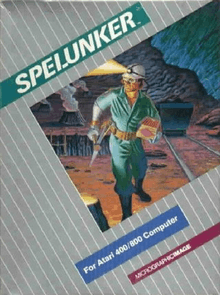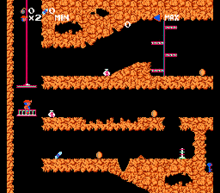Spelunker (video game)
| Spelunker | |
|---|---|
 Front cover of the Atari 8-bit version, the earliest version of the game. | |
| Developer(s) | MicroGraphicImage, Irem |
| Publisher(s) | MicroGraphicImage, Brøderbund |
| Designer(s) | Tim Martin () |
| Platform(s) | Atari 400/Atari 800, Arcade, Commodore 64, MSX, NES, Virtual Console |
| Release date(s) |
|
| Genre(s) | Adventure |
| Mode(s) | Single player |
| Distribution | 16Kb ROM cartridge |
Spelunker is a 1983 video game developed by Tim Martin and MicroGraphicImage. It is a platform game similar to Pitfall! or Curse of Ra.
Originally released by MicroGraphicImage for the Atari 8-bit computers in 1983, the game was later ported to the Commodore 64 and re-released by Brøderbund in 1984, with European publishing rights licensed to Ariolasoft. An arcade version followed in 1985, and the game was released for the NES on December 6, 1985 in Japan and September, 1987 in North America, and for the MSX in 1986. A sequel was also released in arcades and for the NES on September 18, 1987 called Spelunker II: Yūsha e no Chōsen by Irem, in Japan only. The game was re-released for Virtual Console in North America on March 17, 2008[1] and in Europe on September 5, 2008 for the Wii, in both regions on June 6, 2013 for the Wii U and in North America on June 27, 2013 for the Nintendo 3DS.
Setting

Spelunker is set in a colossal cave, with the player starting at the cave's entrance at the top, and the objective is to get to the fabulous treasure at the bottom. To achieve this, the player must walk and jump through increasingly challenging parts of the cave, all the while working with a finite supply of fresh air, which could be replenished at various points.
Some of the hazards the player faces in the cave include water, uneven terrain, steam vents, small ledges, chasms, deadly pits, and large rocks that must be blown away. One of the few enemies are large bats, which drop deadly guano on the player. Additionally, a ghost haunts the cave, appearing randomly and attempting to take the player to the shadow world. By pressing the spacebar (B button for NES version), the player character sends a blast of air from his airtank[2] (uses a Phantom Blaster in the NES version), pushing the ghost away. However, this renders the player's character immobile for a couple of seconds, thus vulnerable to other dangers and further depleting their air supply.
Objects to collect include sticks of dynamite, flares and keys (which come in two different colours). By pressing the "D" key, a stick of dynamite is dropped and ignited. This can be used to blow away big rocks. (Care must be taken to stand far enough away as not to get caught in the blast.) Flares are launched with the "F" key and are used to scare bats away. After the flare is extinguished, the bats return.
Gameplay
.gif)
Much of the game's difficulty arises from the fact that the explorer cannot jump high or fall far, and therefore dies easily. There is also no projectile motion when running off the edge of a cliff so the character will fall straight down. As such, precise positioning and jumping play key factors in successfully completing the game. Additionally, certain versions of the game are very precise about jumping from ropes or ladders. The NES and MSX versions require the player to move sideways before pressing the jump button (risking walking off the ladder or rope). The Atari version and the Commodore version allowed the player to hold the button and tap the joystick instead to make a single jump from a ladder or rope from a standstill.
The splash screen of the game on the original Atari featured an excerpt of Modest Mussorgsky's Pictures at an Exhibition as background music. All other versions of the game, including the Atari re-release featured a different title theme. The NES and MSX versions had additional music during gameplay.
The cave in Spelunker is divided into six levels. Although the levels connect seamlessly to each other, forming one large map, the game clearly signals a level change at certain points by showing the name of the next level and giving the player a bonus, consisting of an extra life and a varying amount of points. Also, depending on memory, the next level or two were loaded from disk at that point. The levels are as follows:
- The Elevator
- An elevator at the left side of the screen can be used for free vertical travel between various pathways.
- The Ropes
- A series of ropes hangs from the ceiling, allowing the player to jump from one rope to another.
- The Falls
- There is a large waterfall inside the cave, and the player actually gets to ride the falls in a barrel. However, unless the rope gun is collected before the player lands the barrel on the island, the player gets permanently trapped, and must start over.
- The Shaft
- An immensely large geyser shoots within a vertical shaft. A small raft floats above the ensuing pillar of water, allowing the player to ride up or down as the geyser shoots and recedes. Managing your air supply is a challenge in this level, because sometimes a long wait is needed to get on the raft.
- The Pyramid
- There is a large pyramid inside the cave. The player must find keys to open locked doors in the pyramid, to proceed from its base to its top.
- The Treasure
- A final series of small ledges lies between the player and the fabulous treasure.
In the NES version, upon completing the last section, a "second quest" is begun. The second quest is another instance of the same maps with some changes. The color scheme is different (green cave walls where they were a brownish color before) and all door keys are now invisible (but conveniently in the same locations they were before). During the third quest, the keys remain invisible and require the player to jump at the proper position to collect the keys. The fourth and fifth quests accelerate various enemies and hazards as well as requiring the player to fire a flare, instead of jumping, in order to collect the invisible keys. All quests after the fifth quest require the player to fire a flare and immediately jump to collect the keys, as well as maintaining the accelerated enemies and hazards.
Reception
Computer Gaming World called Spelunker "a thoroughly enjoyable game ... a class act".[3]
Remakes
Sony Computer Entertainment of Japan has released Spelunker HD, known in Japan as Minna de Spelunker, for the PlayStation 3 as a downloadable game through their PSN Store. It received the PlayStation Store best sales award in 2009 from Sony Computer Entertainment of Japan.[4] The game is a remake of the NES port, with high definition graphics and 100 levels (10 large caves, with 10 levels in each).[5]
Footnotes
- ↑ "Wii-kly Update: Two New Classic Games Added to Wii Shop Channel". Nintendo of America. 17 March 2008. Archived from the original on 17 March 2008. Retrieved 17 March 2008.
- ↑ Reprint of review from Atari Interface, Vol. 4, June 1992 at AtariArchives
- ↑ Stone, David (January 1985). "Spelunker and Realm of Impossibility". Computer Gaming World. p. 33.
- ↑ Note at Homepage
- ↑ http://www.thesixthaxis.com/2008/10/01/spelunker-coming-to-ps3/
External links
- Spelunker guide at StrategyWiki
- Spelunker map (Atari 8-bit version)
- Spelunker at MobyGames
- minna de Spelunker PS3 official site (Japanese)